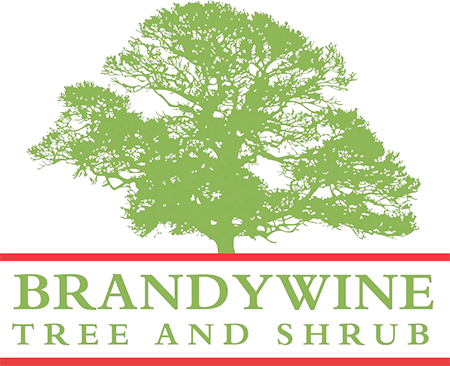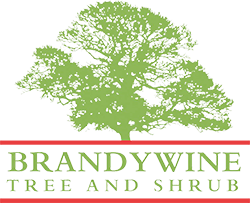Brandywine Tree & Shrub Blog

We invite you to monitor our News Blog for informative articles.
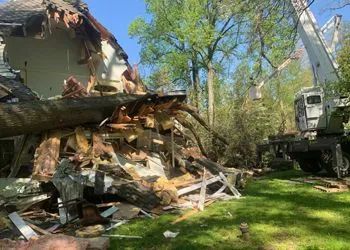
by Brandywine Tree & Shrub
•
21 November 2025
Some big trees can pose serious risks during storms—especially when high winds are involved. A tree that’s structurally weakened or diseased is far more likely to fall, potentially causing severe damage to your home, vehicles, or power lines. Spotting the warning signs early gives you the chance to take preventive action before disaster strikes. At Brandywine Tree & Shrub, our local ISA-certified arborists provide hazardous tree removal in the greater Wilmington, DE area. Here are four signs that a tree may be at increased risk of toppling in high winds. Leaning or Shifting A healthy tree generally grows upright, though some species naturally develop a gentle lean. However, if a tree has recently begun leaning more noticeably, or if the tilt seems to be worsening, that’s a major red flag. Sudden leaning can indicate root instability or soil displacement, especially after heavy rain or wind. Trees that have shifted in the soil may no longer be securely anchored, making them highly vulnerable when strong gusts hit. Cracked Trunk The trunk serves as the backbone of a tree, and any damage to it can compromise structural integrity. Deep cracks and large cavities in the trunk weaken the tree’s ability to withstand high winds. If the trunk looks unstable or hollow, it’s best to have a certified arborist assess the situation before the next storm. Exposed or Damaged Roots Roots are the foundation that keep a tree standing tall, and any damage to them can dramatically increase the risk of toppling. If you see roots lifting out of the ground, exposed near the surface, or showing signs of rot, the tree may no longer have the strong anchor it needs. Construction work, soil erosion, and poor drainage can all harm roots over time. Trees with compromised root systems often give way suddenly under pressure from high winds. Fungal Growth Around the Base Fungal growth near the tree’s base often indicates internal decay in the roots or lower trunk. While some surface fungi are generally harmless, others suggest that the wood beneath is rotting and losing strength. A tree suffering from internal decay may appear healthy at first glance but can fail unexpectedly under wind stress. If you spot fungus or soft, spongy wood near the roots, it’s important to have the tree inspected right away. Tree Removal in Wilmington, DE For expert tree removal in Wilmington or Milford, DE and the surrounding area, contact Brandywine Tree & Shrub at 302-278-6387 . Feel free to give us a call to request an arborist estimate in Wilmington!
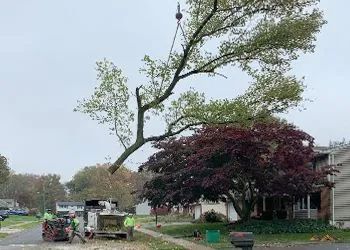
by Brandywine Tree & Shrub
•
24 October 2025
Tree removal may seem like a task you can handle on your own, but it’s far more complex and dangerous than it appears. From towering heights to hidden structural weaknesses, tree removal requires expert knowledge, specialized equipment, and a strategic approach. Hiring an ISA-certified arborist enables the job to be completed safely, efficiently, and in accordance with industry standards. At Brandywine Tree & Shrub, our local ISA-certified arborists provide expert tree removal in the greater Wilmington, DE area. If you’re considering taking down a tree yourself, here are four important reasons why it’s best to leave the work to a certified professional instead. Safety and Risk Prevention Tree removal is one of the most dangerous outdoor tasks a homeowner can attempt. Falling branches, unstable trees, and heavy equipment can all cause serious injuries or property damage. ISA-certified arborists are trained in safety protocols and use proper climbing gear, rigging systems, and cutting techniques to control the direction of each fall. Their experience dramatically lowers the risk of accidents and helps ensure the surrounding property remains unharmed during the process. Expert Knowledge and Assessment ISA-certified arborists are trained professionals who understand tree structure and stability. Before removing a tree, they assess its condition, root system, and proximity to nearby structures. What may look like a simple tree to you could have internal decay, weak branches, or a compromised trunk that makes removal risky. An arborist’s expert evaluation ensures the safest and most effective removal plan, reducing the risk of unexpected hazards. Proper Equipment and Techniques Removing a tree requires more than just a chainsaw. Arborists use cranes, stump grinders, rigging ropes, and harnesses to dismantle trees in tight or hazardous spaces. Without the right tools or training, DIY attempts can result in damage to fences, roofs, or landscaping. Certified arborists know how to use professional-grade equipment to complete the job efficiently and safely, no matter the tree’s size or location. Thorough Cleanup Once the tree is down, the work isn’t over. Branches, logs, and other debris can leave your yard cluttered and unsafe. Arborists include cleanup as part of their service, hauling away debris and grinding the stump if requested. They leave your property neat, hazard-free, and ready for replanting or landscaping, saving you the time and effort of dealing with the aftermath yourself. Tree Removal in Wilmington, DE For expert tree removal in Wilmington or Milford, DE and the surrounding area, contact Brandywine Tree & Shrub at 302-278-6387 . Feel free to give us a call to arrange an arborist estimate in Wilmington!

by Brandywine Tree & Shrub
•
21 November 2025
Some big trees can pose serious risks during storms—especially when high winds are involved. A tree that’s structurally weakened or diseased is far more likely to fall, potentially causing severe damage to your home, vehicles, or power lines. Spotting the warning signs early gives you the chance to take preventive action before disaster strikes. At Brandywine Tree & Shrub, our local ISA-certified arborists provide hazardous tree removal in the greater Wilmington, DE area. Here are four signs that a tree may be at increased risk of toppling in high winds. Leaning or Shifting A healthy tree generally grows upright, though some species naturally develop a gentle lean. However, if a tree has recently begun leaning more noticeably, or if the tilt seems to be worsening, that’s a major red flag. Sudden leaning can indicate root instability or soil displacement, especially after heavy rain or wind. Trees that have shifted in the soil may no longer be securely anchored, making them highly vulnerable when strong gusts hit. Cracked Trunk The trunk serves as the backbone of a tree, and any damage to it can compromise structural integrity. Deep cracks and large cavities in the trunk weaken the tree’s ability to withstand high winds. If the trunk looks unstable or hollow, it’s best to have a certified arborist assess the situation before the next storm. Exposed or Damaged Roots Roots are the foundation that keep a tree standing tall, and any damage to them can dramatically increase the risk of toppling. If you see roots lifting out of the ground, exposed near the surface, or showing signs of rot, the tree may no longer have the strong anchor it needs. Construction work, soil erosion, and poor drainage can all harm roots over time. Trees with compromised root systems often give way suddenly under pressure from high winds. Fungal Growth Around the Base Fungal growth near the tree’s base often indicates internal decay in the roots or lower trunk. While some surface fungi are generally harmless, others suggest that the wood beneath is rotting and losing strength. A tree suffering from internal decay may appear healthy at first glance but can fail unexpectedly under wind stress. If you spot fungus or soft, spongy wood near the roots, it’s important to have the tree inspected right away. Tree Removal in Wilmington, DE For expert tree removal in Wilmington or Milford, DE and the surrounding area, contact Brandywine Tree & Shrub at 302-278-6387 . Feel free to give us a call to request an arborist estimate in Wilmington!

by Brandywine Tree & Shrub
•
24 October 2025
Tree removal may seem like a task you can handle on your own, but it’s far more complex and dangerous than it appears. From towering heights to hidden structural weaknesses, tree removal requires expert knowledge, specialized equipment, and a strategic approach. Hiring an ISA-certified arborist enables the job to be completed safely, efficiently, and in accordance with industry standards. At Brandywine Tree & Shrub, our local ISA-certified arborists provide expert tree removal in the greater Wilmington, DE area. If you’re considering taking down a tree yourself, here are four important reasons why it’s best to leave the work to a certified professional instead. Safety and Risk Prevention Tree removal is one of the most dangerous outdoor tasks a homeowner can attempt. Falling branches, unstable trees, and heavy equipment can all cause serious injuries or property damage. ISA-certified arborists are trained in safety protocols and use proper climbing gear, rigging systems, and cutting techniques to control the direction of each fall. Their experience dramatically lowers the risk of accidents and helps ensure the surrounding property remains unharmed during the process. Expert Knowledge and Assessment ISA-certified arborists are trained professionals who understand tree structure and stability. Before removing a tree, they assess its condition, root system, and proximity to nearby structures. What may look like a simple tree to you could have internal decay, weak branches, or a compromised trunk that makes removal risky. An arborist’s expert evaluation ensures the safest and most effective removal plan, reducing the risk of unexpected hazards. Proper Equipment and Techniques Removing a tree requires more than just a chainsaw. Arborists use cranes, stump grinders, rigging ropes, and harnesses to dismantle trees in tight or hazardous spaces. Without the right tools or training, DIY attempts can result in damage to fences, roofs, or landscaping. Certified arborists know how to use professional-grade equipment to complete the job efficiently and safely, no matter the tree’s size or location. Thorough Cleanup Once the tree is down, the work isn’t over. Branches, logs, and other debris can leave your yard cluttered and unsafe. Arborists include cleanup as part of their service, hauling away debris and grinding the stump if requested. They leave your property neat, hazard-free, and ready for replanting or landscaping, saving you the time and effort of dealing with the aftermath yourself. Tree Removal in Wilmington, DE For expert tree removal in Wilmington or Milford, DE and the surrounding area, contact Brandywine Tree & Shrub at 302-278-6387 . Feel free to give us a call to arrange an arborist estimate in Wilmington!
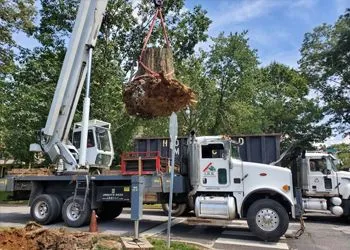
by Brandywine Tree & Shrub
•
20 September 2025
When a tree is cut down, the job isn’t truly finished until the stump is dealt with. Many property owners leave stumps behind, assuming they’re harmless or not worth the effort to remove. However, tree stumps can cause a variety of problems over time, from safety hazards to pest issues. Hiring a professional to remove stumps ensures the job is done safely, efficiently, and completely. At Brandywine Tree & Shrub, our local ISA-certified arborists provide expert stump grinding and removal in the greater Wilmington area. Here are five benefits of professional stump removal. Stops Unwanted Regrowth Many tree stumps, if left in the ground, will continue to sprout new shoots. These suckers can become a persistent nuisance, requiring repeated trimming and consuming nutrients that could otherwise benefit your lawn or garden. Professional stump grinding removes the root system along with the stump, preventing regrowth and ensuring that the tree is gone for good. Enhances Curb Appeal Tree stumps can detract from the beauty of your yard, making it look neglected. Removing stumps instantly improves the appearance of your property. Professionals can leave your yard smooth and ready for landscaping upgrades. Eliminates Safety Hazards Leftover stumps can be dangerous obstacles in your yard, especially for children at play or visitors unfamiliar with the space. Tripping over a hidden or low stump can result in injuries, and stumps can also damage lawnmowers and other equipment. Professional removal makes your yard safer, giving you peace of mind. Prevents Pest Infestations Tree stumps are prime real estate for unwanted pests such as termites, carpenter ants, and beetles. These pests often spread to healthy trees or even your home’s structure, leading to costly problems. Removing stumps professionally eliminates this breeding ground before pests can take hold, helping protect both your yard and your home. Creates More Usable Space Every square foot of your yard is valuable, especially if you want to make the most of your outdoor living area. A stump takes up space that could be used for a new garden bed, lawn, patio, or play area. Once professionals remove the stump, the area can be repurposed however you choose, giving you greater flexibility to enhance your property. Stump Grinding & Removal in Wilmington, DE For expert stump removal in Wilmington or Milford, DE and the surrounding area, contact Brandywine Tree & Shrub at 302-278-6387 . Feel free to give us a call to ask for an arborist estimate in greater Wilmington!
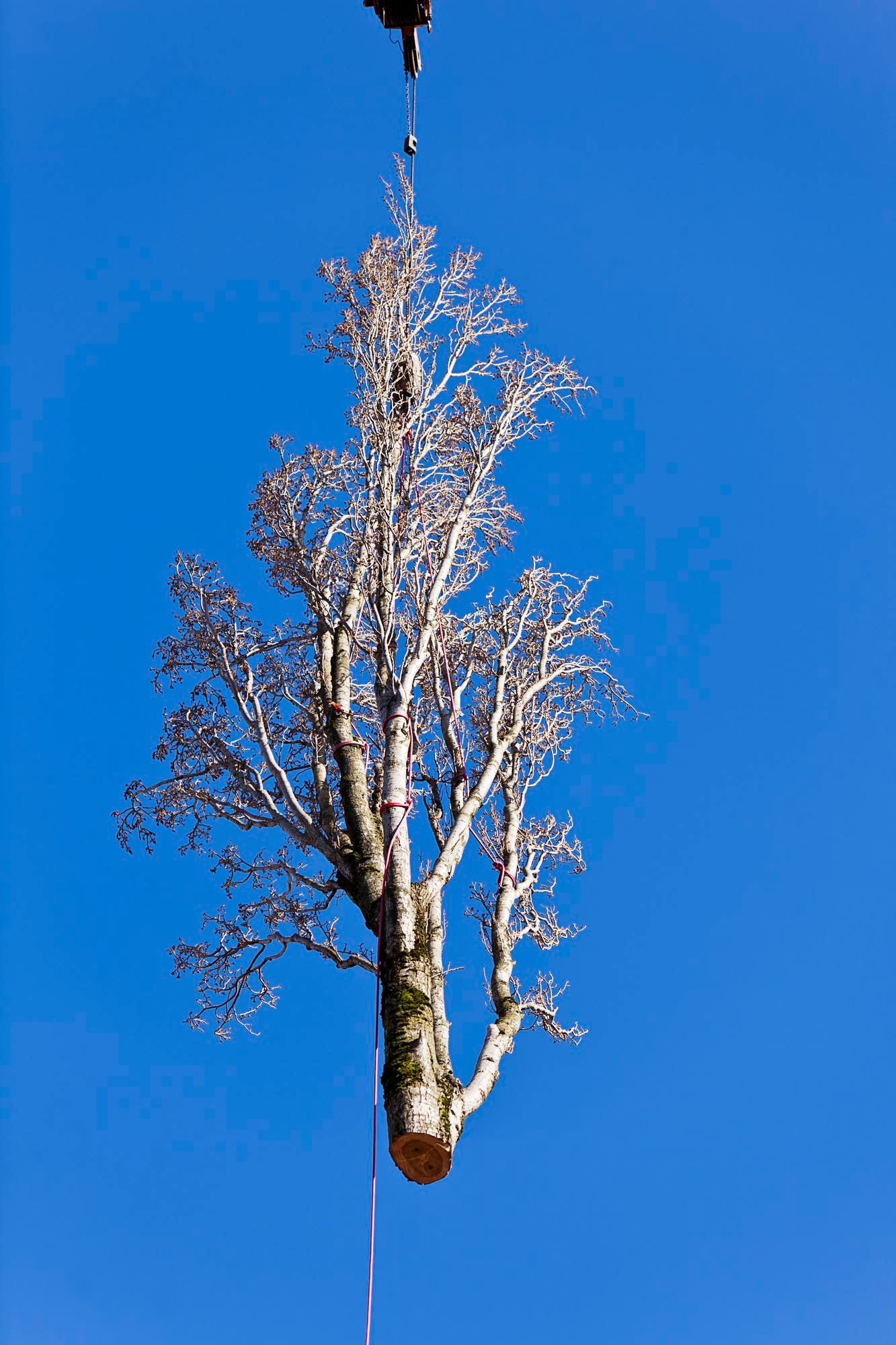
by Brandywine Tree & Shrub
•
21 August 2025
Dead trees may seem harmless at first glance, especially if they’ve been standing without issue for a while. But in reality, a dead tree can quickly become a dangerous liability. Whether due to disease, pests, or age, dead trees lose structural integrity and can cause a wide range of problems. Taking action early to remove them isn’t just about improving appearances—it’s about protecting your property and the people on it. At Brandywine Tree & Shrub, our local ISA-certified arborists can identify dead trees and safely remove them as necessary. Here are four important reasons why proactive removal of dead trees is essential. They Pose a Serious Safety Hazard One of the biggest risks of leaving a dead tree standing is the danger of falling branches or complete tree collapse. Dead wood becomes brittle and unstable, making it far more likely to break under the pressure of wind or rain. If the tree is near a home, driveway, sidewalk, or play area, falling limbs could cause injuries or serious property damage. Being proactive protects your family, guests, and neighbors from harm. Storms Can Quickly Turn Dead Trees into Emergencies Even a moderate storm can turn a dead tree into a disaster waiting to happen. High winds and heavy rainfall often weaken already-compromised trees, increasing the chances they’ll fall. Once a storm hits, it may be too late to remove the tree safely. Acting ahead of time reduces the risk of unexpected emergencies, cleanup costs, and insurance claims. Dead Trees Attract Pests and Disease A dead tree can become a breeding ground for pests like termites, carpenter ants, and beetles. These insects often spread to nearby healthy trees or even your home. Also, some tree diseases can linger in dead wood and infect surrounding vegetation. Removing dead trees promptly helps prevent infestations and the spread of disease throughout your yard and neighborhood. They Lower Your Property’s Curb Appeal Dead trees are unattractive and can negatively impact curb appeal. If you’re thinking of selling your home, potential buyers may view dead trees as a red flag—suggesting neglect or future maintenance issues. Even if you’re not planning to sell, maintaining a clean and healthy landscape helps preserve your property’s value and appeal. Tree Removal in Wilmington, DE For expert tree removal in Wilmington or Milford, DE and the surrounding area, contact Brandywine Tree & Shrub at 302-219-6092 . Feel free to give us a call to ask for an arborist estimate in Wilmington!
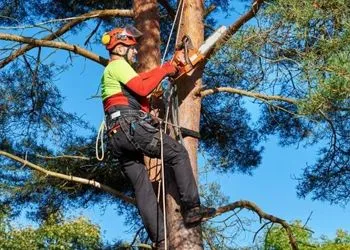
by Brandywine Tree & Shrub
•
21 July 2025
One of the most important aspects of tree maintenance is pruning. While it may seem like a simple task, tree pruning is actually a highly skilled process that requires knowledge of tree biology and proper cutting techniques. That’s why it’s best to trust the job to an ISA-certified arborist. Certification by the International Society of Arboriculture means the arborist has met high standards of expertise and ethical practices. At Brandywine Tree & Shrub, our local ISA-certified arborists provide expert pruning in the greater Wilmington, DE area. Here are four benefits of having your trees pruned by an ISA-certified professional. Promotes Healthy Growth Pruning isn’t just about shaping a tree’s appearance. When done correctly, it helps stimulate healthy growth by removing dead, diseased, or overcrowded branches. ISA-certified arborists understand how to make precise cuts that encourage strong structure and vitality. They are trained to avoid over-pruning, which can stress the tree and reduce its ability to thrive. With professional care, your trees are more likely to develop properly and remain resilient over time. Reduces the Risk of Property Damage Overgrown or damaged limbs can pose a serious risk to nearby structures, vehicles, and people. Storms, wind, and decay can cause weak branches to snap and fall, potentially leading to costly damage or injury. ISA-certified arborists know how to assess structural integrity and identify limbs that need to be removed before they become hazardous. Their expertise helps prevent accidents and keeps your property safer year-round. Improves Tree Appearance and Aesthetics A well-pruned tree contributes to the overall curb appeal of your landscape. ISA-certified arborists have the experience to shape trees in a way that enhances their natural beauty while maintaining balance and symmetry. They understand species-specific growth habits and can tailor their approach to achieve the best visual results without compromising tree health. Protects Against Pests and Disease Diseased or decaying branches can attract insects and promote the spread of pathogens. Removing these problem areas through proper pruning reduces the chance of infestations and keeps your trees healthier. ISA-certified arborists are trained to recognize early signs of disease or pest activity and can recommend additional treatments or care strategies if needed. This proactive approach helps maintain the long-term health of your trees. ISA-Certified Arborists in Wilmington, DE When you need professional tree pruning in Wilmington or Milford, DE and the surrounding area, contact Brandywine Tree & Shrub at 302-278-6387 . Feel free to give us a call to arrange an arborist estimate in Wilmington!
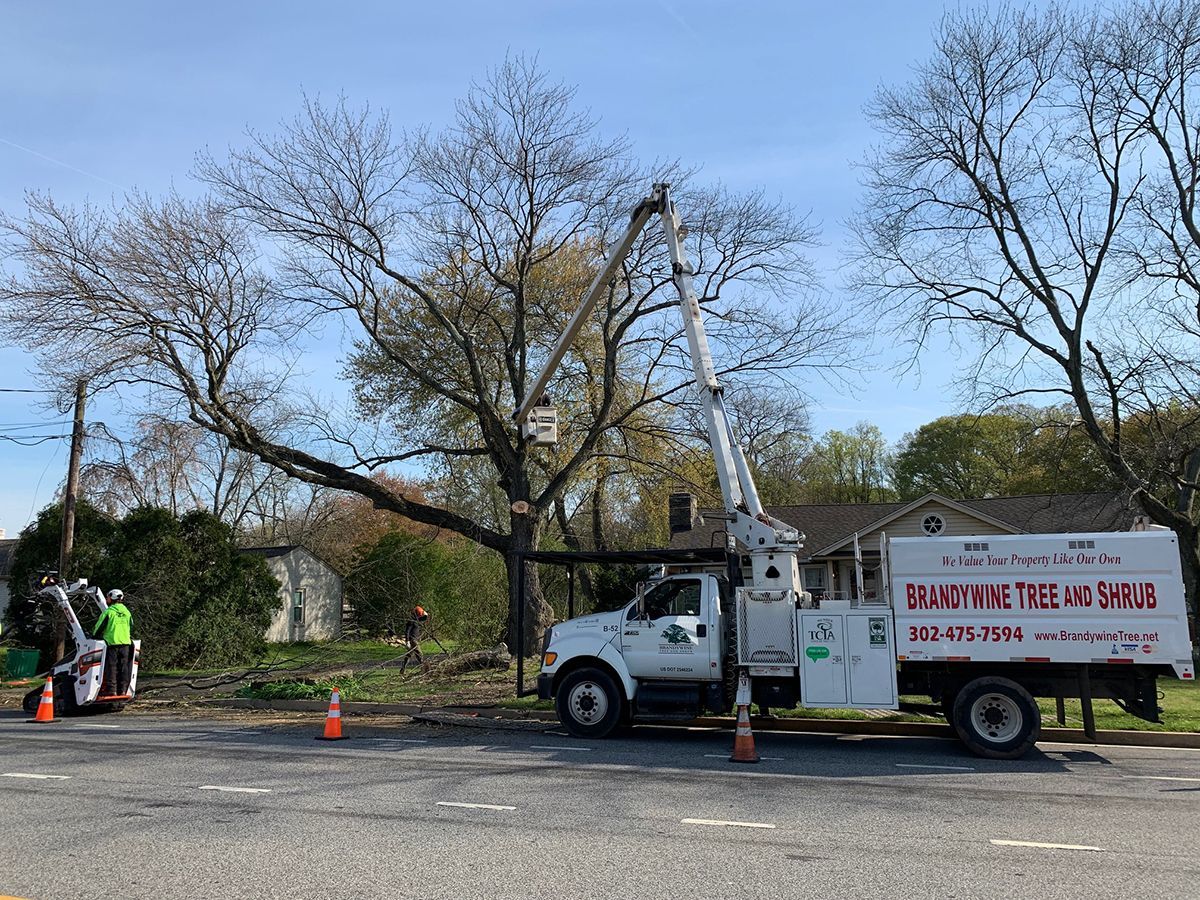
by Brandywine Tree & Shrub
•
22 June 2025
Big trees can quickly become serious hazards if their health or structure is compromised. A tree that seems majestic from a distance may be silently posing a danger to your home and family. Recognizing the warning signs early can prevent costly damage and help ensure the safety of everyone on your property. At Brandywine Tree & Shrub, our local ISA-certified arborists can identify hazardous trees and safely remove them as needed. Here are four signs that a big tree may be putting your home at risk. Leaning Toward the House While some trees naturally grow at an angle, a sudden lean toward your home can indicate a structural problem. This may be due to root damage or soil erosion. If the lean is accompanied by cracked soil at the base or visible root lifting, the tree may be unstable and at risk of falling. A tree leaning in the direction of your home should be assessed by a certified arborist as soon as possible. Large Dead/Hanging Branches Dead limbs or hanging branches are a clear warning that the tree is struggling and may be in decline. These branches are more likely to fall unexpectedly, especially during windy or stormy conditions. If these branches are located over your home, driveway, or areas where people commonly walk or gather, they pose a significant safety hazard and should be removed immediately. Substantial Cracks in the Trunk Visible cracks, splits, or cavities in the trunk are signs of structural weakness. These openings often make the tree more vulnerable to breaking, especially during storms or high winds. If the damage is extensive or located near the base of the trunk, it may compromise the entire tree’s integrity. Even if the tree still appears healthy on the outside, internal damage can make it a serious liability. Root Damage or Exposure A tree’s root system anchors it in place and provides essential nutrients. If you notice exposed roots, soil upheaval, or signs of root rot, the tree may not be as secure as it looks. Roots can be damaged by construction and heavy machinery. When the root system is compromised, the tree is much more likely to fall without warning, especially in adverse weather. Tree Removal in Wilmington, DE When you need tree removal in Wilmington or Milford, DE and the surrounding area, contact Brandywine Tree & Shrub at 302-278-6387 . Feel free to give us a call to arrange an arborist estimate in Wilmington!
